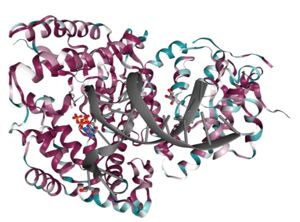DNA Polymerase Theta
From Proteopedia
Structural DescriptionThe polymerase domain of DNA polymerase theta () is a member of the A-family of polymerases which includes Pol I [1] and T7 DNA polymerase [2]. A-family polymerases contain . These motifs allow for identification of A-family polymerases based on their amino acid sequence. In addition to the A-family motifs, the subdomains that are typical of many polymerases are also conserved in QM1. The coordinate the template and the while the performs catalysis and the contacts the double stranded DNA. Within these subdomains exist disordered structural inserts that are not present in bacterial homologs. These inserts impart unique properties to QM1; in the thumb increases processivity while inserts and facilitate the ability of QM1 to bypass that typically block synthesis by other A-family polymerases. This error prone synthesis makes QM1 more functionally similar to Y-family translesion polymerases. Beyond the canonical polymerase folds, QM1 also possesses a vestigial domain that no longer performs proof-reading activities. This domain also contains that are thought to contact the more distant helicase-like and central domains of full-length polymerase theta (see Function). It is thought that QM1 may function as a dimer, as dimerization interfaces were identified in the of the crystal structure. The presence of dimerization in solution has not yet been confirmed. Key InteractionsThe residues of the palm subdomain contact the divalent calcium ion which coordinates the triphosphate tail of the incoming ddATP in the active site. Highly conserved lysine and arginine residues in the of the fingers subdomain contact the alpha and gamma phosphates in the triphosphate tail as well. An additional O-helix contact is made through a residue that makes pyrophosphate a better leaving group. Insertion loop 2 contains an residue that contacts the primer DNA at its 3' terminal phosphate. This interaction is key for accommodating DNA lesions in the active site. The thumb subdomain interacts with the backbone of the primer strand through [3] FunctionFull length polymerase theta consists of an N-terminal helicase-like domain that is connected to the C-terminal polymerase domain by a central linker region [4]. Polymerase theta is a DNA double strand break repair protein. Double strand breaks can occur as a result of both exogenous (ionizing radiation) and endogenous (reactive oxygen species, replication fork collapse) damage. To repair breaks, polymerase theta employs theta-mediated end-joining (TMEJ), which is a form of alternative end-joining (altEJ). TMEJ begins with pairing of microhomologies in 3' single stranded overhangs that have been exposed through 5' end resectioning at the site of the break. If the microhomologies are internal to the 3' end of the overhanging DNA, the resulting flaps will be removed and a deletion will be introduced. If microhomologies arise from brief templated synthesis with a more distant strand, insertions will occur. Once microhomologies are aligned, pol theta synthesizes DNA to fill the gaps on either side of the microhomologies.[5] Sequence ConservationThe sequence of QM1 is highly conserved as it belongs to a distinct family of polymerases. The majority of conserved residues reside in the interior of the channel that contacts the DNA and incoming nucleotide indicating that these regions are critical to polymerase function and catalysis. Less sequence conservation is observed in the exterior alpha helices as the residues are exposed at the surface and alpha helices can tolerate more variation in amino acid composition than other secondary structural elements. RelevancePolymerase theta over-expression in a number of cancers including breast cancer, non-small cell lung cancer, and oral squamous cell carcinoma is correlated with poor survival rates. Due to the role polymerase theta plays in double strand break repair, cells that over express polymerase theta are better able to repair damage caused by ionizing radiation treatment and chemotherapy. By developing compounds that inhibit polymerase theta activity in cancer cells, traditional cancer therapies can be made more effective in cancers that express high levels of polymerase theta. References
| ||||||||||||


